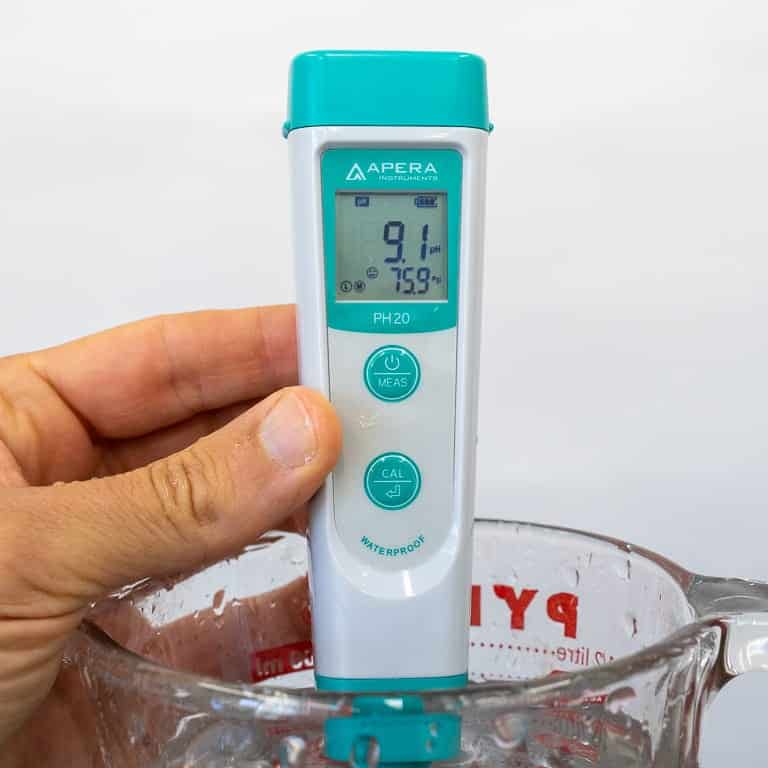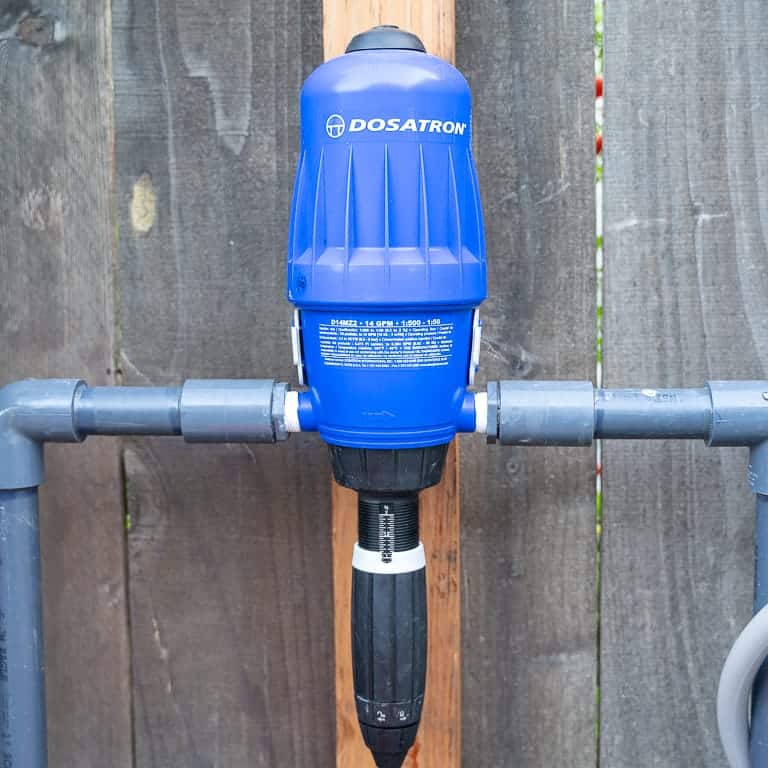I found out that the pH of my water can get pretty high a long time ago. It’s not too bad when it’s in the lower ranges, but it definitely needs attention when it creeps into the higher ranges – which it did this summer.
pH is a measure of how acidic or basic water is. Because it can change from season to season and from year to year, I have to monitor it on a regular basis and treat the water when it gets too far out of whack.
Generally speaking, bonsai prefer slightly acidic water (pH below 7.0). Municipal water is commonly basic (pH above 7.0). The higher the pH, the harder it is to keep bonsai healthy.
There’s no perfect pH for irrigation water as the optimal pH for a given nutrient is different from one nutrient to the next.
As noted in the last post, the fertilizers we use can affect the pH and help keep our trees green. The same is true for many bonsai soils as both akadama and kanuma have some ability to minimize the effect of basic (or acidic) water on our trees.
Soil and fertilizer, however, can only do so much. Which brings us to the first step for making improvements: getting an accurate measure of the water’s pH.
The most common ways to measure pH are with a freshwater test kit, test strips, or a pH meter. Paper test strips are easy to use but not very accurate so I don’t recommend them for testing irrigation systems. Both freshwater test kits and pH meters make it easy to get an accurate reading.

A pH meter showing the pH and the water temperature
Depending on how high your pH is and how much trouble you have keeping your bonsai healthy, it might be time to make a change. Here are some basic options for growers with high pH water.
- Collect rainwater. Rainwater is commonly more acidic than municipal or well water and can be a great option for watering bonsai.
- Add vinegar (or other acids) to the water in your watering can. This approach is good for smaller collections but doesn’t work as well when you have lots of trees.
- Use a siphon mixer. A siphon system like the Hozon Brass Siphon Mixer can draw an acidic solution from a reservoir (a 5-gallon bucket can work) and automatically mix it with the water coming from the spigot. This is the most simple and cost effective approach to acidifying your water. (For details about this approach, see Michael Hagedorn’s post on the topic here and check out the results a friend of his achieved here.)
- Use an injection system. Injection systems like the Dosatron use a pump mechanism to add a precise amount of acid (or fertilizer) to your water. These systems are more expensive and require more set-up than the above approaches but offer accuracy and flexibility. (A big, and seriously delayed, thank you to Matthiew Quinn of Montréal for suggesting I get one back in 2013 – thanks Matthiew!)
- Use a reverse osmosis system. Reverse osmosis or “RO” systems take a brute force approach to purifying water. They can be great when water quality is low but aren’t the best approach when the only issue is high pH.

Dosatron fertilizer injector
With the exception of reverse osmosis systems, the above options are fairly straightforward to set up. The main thing is to choose an approach that works for your garden and to test regularly to ensure the system is doing what you expect it to.
The next step is to select an acid to add to the water. The most common choices are acetic acid (vinegar), citric acid, phosphoric acid, muriatic acid (aka hydrochloric acid), nitric acid, and sulfuric acid. Products like pH Down use both phosphoric and citric acid; muriatic acid can be found in home centers alongside other solvents and cleaners.
I have yet to try all of the different acids but I have become a fan of using acetic acid. 30% vinegar is easily available and makes a good starting point for acidifying water. Were I to try another acid I’d try citric acid which is commonly available in powder form. All acids should be treated with caution and handled with care – and adequate safety equipment.
My plan is to add either fertilizer or acid to my water every time I water my trees. My goal in doing this is to see how healthy I can get my trees before winter to help them grow better next spring. Will report back on the results.
Subscribe to Bonsai Tonight
New Posts Delivered Every Tuesday and Friday
Zack Clayton, CBS Editor says
Jonas, I linked your series on sacrifice branches and this series in the Columbus Bonsai newsletter in a section called “Found on the Web” You make a frequent appearance there because you notice an issue, pursue the cause and then publish your findings. I find this a refreshing approach and one that is not only informative, but also educational in that the root causes are discussed. Well done sir.
Jonas Dupuich says
Thanks Zack, I appreciate it! It looks like a ton of effort goes into the newsletter – it’s a great resource. Do let me know if there are specific topics you’d like to see in future posts and I’ll see what I can do. Thanks again!
Jay says
Is there a problem using Tannic acid from the breakdown of leaves/pine needles?
Jonas Dupuich says
Good question Jay – I have no idea as it’s not as commonly used to treat water from what I’ve seen. Considering that a similar effect contributes to trees growing in nature I’d expect it to be OK, but I don’t know how it would behave when adding it to our irrigation water (and that will likely depend on the water alkalinity).
It’d be great to hear from anyone who has experience with tannic acid as it relates to irrigation.
Alessandro says
Hi Jay, in fishkeeping to lower ph many enthusiast use tannic acid and most of them uses peat/turf.
Hope this helps!
Jonas Dupuich says
Interesting – if it’s safe for fish I’d expect it to be OK for trees too. Thanks for the heads up Alessandro!
Joe Vincenti says
Dear Jonas
I have the same problem in Malta. Even collected rainwater (only 5-6 months of the year)has a high pH of 8-9 and a high particle density. I have been using a 200Ltr drum to blend the water with normal red household vinegar to reach a pH of 6 successfully for a number of years. The open top drum also helps to breath out the chorine found in the utility water.
Great article
Jonas Dupuich says
Hi Joe, thanks for writing! That sounds like a great solution you’ve come up with. Have you noticed an improvement in the health of your trees?
Joe Vincenti says
Yes Jonas, healthy garden. However as you know it is only in combination with several other interventions. e.g. Fertilizer schedules, including timing and NPK types etc; I am a strong believer in foliage spraying with organic fish/hemp fertilizer according to the lunar cycles.
Having said all that, most of my trees are suited to our harsh hot climate and tend to lean to the alkaline side. Other imported trees which tend more to a low pH need more care. I give everything an iron boost twice a year by drenching the soil mix in spring and late summer. I believe that it helps increase the electro conductive balance in the subsoil.
Jonas Dupuich says
Thanks Joe – it sounds like your trees are on a great fertilzier regimen! I especially like to hear that you primarily grow trees that are well-suited to your environment – it can make a big difference!
Lee Hardt says
Hey Jonas, Hope all is well.
Being a Science geek that is in to the bonsai I would like to add my prospective.
Really you are not injecting to make the water acidic. Some water sources cause the pH of a growing medium to rise rapidly over time. This has nothing to do with the pH of the water, but rather with the alkalinity in the water. Alkalinity is a measure of the bicarbonates and carbonates in the water. Another way to understand water alkalinity is that it is a measure of the limestone content in the water. The higher the alkalinity, the more limestone that is being applied, causing the pH of the growing medium to climb. To offset this pH rise, acids are injected into the irrigation water to neutralize some of the alkalinity and reduce the limestone content in the water.
What acids are best?
H3C6H5O7 aka Citric acid
H2NO3 aka Nitric acid
H3PO4 aka Phosphoric acid
H2SO4 aka Sulfuric acid
These are not only effective, but also offer nutrients to the trees.
The guy asking about the tannic acid, it would be effective due to its conjugate.
Great read as always!
Lee
Jonas Dupuich says
Hi Lee – thanks for the science notes, I appreciate it!
Michael says
Hi Jonas
For the past two years I’ve been fertilizing my trees with every watering. I’m also using an injection system (cheap dosatron clone) and keep the EC value of the solution at around 1000 mS/cm. For nutrients I’m using water soluble salts from a brand called Hakaphos (I’m using the “Blue” variant, with 15-10-15). I’m doing this with all my trees, even the more refined ones and I’m very pleased with the results. One thing that I found very important is that when you water, you really have to water aggressively, so that there’s no salt build-up in the soil.
Best regards,
Michael
Jonas Dupuich says
Thanks for the tips Michael! Watching for salt build-up makes sense – that’s one consideration for approaches that involve daily fertilizing. And if you can maintain fine growth on mature trees and vigorous growth on young trees, that sounds great!